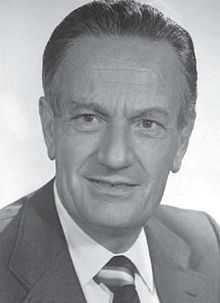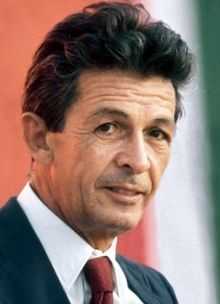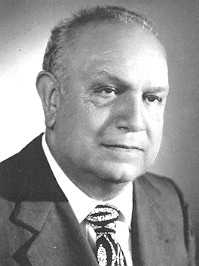Italian general election, 1976
Italian general election, 1976

|
|
|
|
|
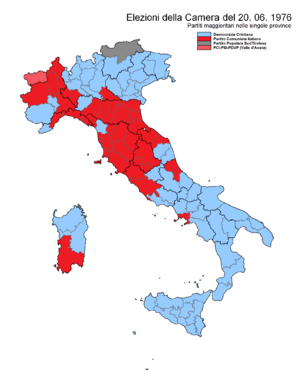
|
| Legislative election results map. Light Blue denotes provinces with a Christian Democratic plurality, Red denotes those with a Communist plurality, Dark gray denotes those with a South Tyrolean People's Party plurality. |
|
General elections were held in Italy on June 20, 1976.[1] They were the first after the voting age was lowered to 18.
If Christian Democracy remained stable with around 38% of votes, Enrico Berlinguer's Italian Communist Party made a great jump winning 7 points more than four years before: this result, which was quite homogeneous in the entire society because confirmed by the electors of the age-restricted Senate,[2] began to show the possibility of a future change of the Italian government leadership. All minor parties lost a lot of votes to the DC in the attempt to fight the Communist progress: between them, historic Italian Liberal Party was nearly annihilated. Two new leftist forces made their debut in this election: the ultra-liberal Radical Party, which had led a successful referendum on divorce, and the far-left Marxist and Maoist Proletarian Democracy.
Electoral system
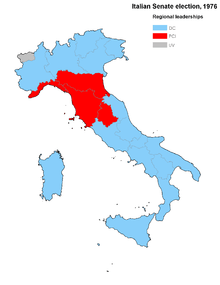
Regional pluralities in Senate
The pure party-list proportional representation had traditionally become the electoral system for the Chamber of Deputies. Italian provinces were united in 32 constituencies, each electing a group of candidates. At constituency level, seats were divided between open lists using the largest remainder method with Imperiali quota. Remaining votes and seats were transferred at national level, where they was divided using the Hare quota, and automatically distributed to best losers into the local lists.
For the Senate, 237 single-seat constituencies were established, even if the assembly had risen to 315 members. The candidates needed a landslide victory of two thirds of votes to be elected, a goal which could be reached only by the German minorities in South Tirol. All remained votes and seats were grouped in party lists and regional constituencies, where a D'Hondt method was used: inside the lists, candidates with the best percentages were elected.
Parties and leaders
Results
Face to the great result of the PCI, many centrist politicians and businessmen began to think how to avoid the possibility of a future Communist victory which could turn Italy into a Soviet-aligned State. So the DC leadership thought to gradually involve the Communists into the governmental policies so to moderate their requests, as made with the Socialists. The man which was chosen for this attempt did not belong to the leftist wing of the DC, as happened with the PSI, but the moderate leader and former-PM Giulio Andreotti, so to balance the situation and to calm the markets. Its first government ended in 1978, when the PCI decided to grant its external support. However this process, called National Solidarity, was dramatically stopped by the terroristic attacks of the Red Brigades, which kidnapped and killed former-PM Aldo Moro. The country was heavily shocked by these killings, and the Communists returned to a full opposition. Andreotti's attempt then to form a classic centre-left government with the Socialists failed, an a new general election was called for 1979.
Chamber of Deputies
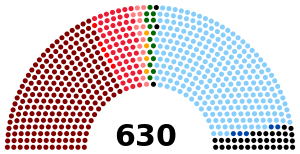
Composition of the Chamber of Deputies after the election.
| Party |
Votes |
% |
Seats |
+/– |
|---|
|
Christian Democracy | 14,209,519 | 38.71 | 263 | –3 |
|
Italian Communist Party | 12,614,650 | 34.37 | 228 | +49 |
|
Italian Socialist Party | 3,540,309 | 9.64 | 57 | –4 |
|
Italian Social Movement | 2,238,339 | 6.10 | 35 | –21 |
|
Italian Democratic Socialist Party | 1,239,492 | 3.38 | 15 | –14 |
|
Italian Republican Party | 1,135,546 | 3.09 | 14 | –1 |
|
Proletarian Democracy | 557,025 | 1.52 | 6 | new |
|
Italian Liberal Party | 480,122 | 1.31 | 5 | –15 |
|
Radical Party | 394,439 | 1.07 | 4 | new |
|
South Tyrolean People's Party | 184,375 | 0.50 | 3 | – |
|
PCI–PSI–PdUP | 26,748 | 0.07 | 1 | – |
|
Others | 87,014 | 0.24 | 0 | – |
| Invalid/blank votes | 1,045,512 | – | – | – |
| Total | 37,755,090 | 100 | 630 | 0 |
| Registered voters/turnout | 40,426,658 | 93.39 | – | – |
| Source: Ministry of the Interior |
Senate of the Republic
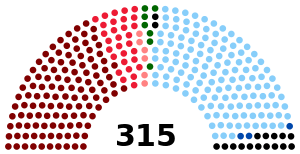
Composition of the Senate after the election.
| Party |
Votes |
% |
Seats |
+/– |
|---|
|
Christian Democracy | 12,227,353 | 38.88 | 135 | – |
|
Italian Communist Party | 10,637,772 | 33.83 | 116 | +22 |
|
Italian Socialist Party | 3,208,164 | 10.20 | 29 | –4 |
|
Italian Social Movement | 2,086,430 | 6.63 | 15 | –11 |
|
Italian Democratic Socialist Party | 974,940 | 3.10 | 6 | –5 |
|
Italian Republican Party | 846,415 | 2.69 | 6 | +1 |
|
Italian Liberal Party | 438,265 | 1.39 | 2 | –6 |
|
PLI–PRI–PSDI | 334,898 | 1.06 | 2 | – |
|
Radical Party | 265,947 | 0.85 | 0 | new |
|
South Tyrolean People's Party | 158,584 | 0.50 | 2 | – |
|
Proletarian Democracy | 78,170 | 0.25 | 0 | new |
|
PCI–PSI | 52,922 | 0.17 | 1 | +1 |
|
PLI–PRI | 51,353 | 0.16 | 0 | – |
|
DC–RV–UV–UVP–PRI | 22,917 | 0.07 | 1 | – |
|
Others | 65,301 | 0.22 | 0 | – |
| Invalid/blank votes | 1,888,027 | – | – | – |
| Total | 32,621,581 | 100 | 315 | 0 |
| Registered voters/turnout | 34,928,214 | 93.4 | – | – |
| Source: Ministry of the Interior |
References
- ↑ Nohlen, D & Stöver, P (2010) Elections in Europe: A data handbook, p1048 ISBN 978-3-8329-5609-7
- ↑ While the electorate for the House had been expanded from 21-year-old citizens to 18, it had remained unvaried at 25 for the Senate.



